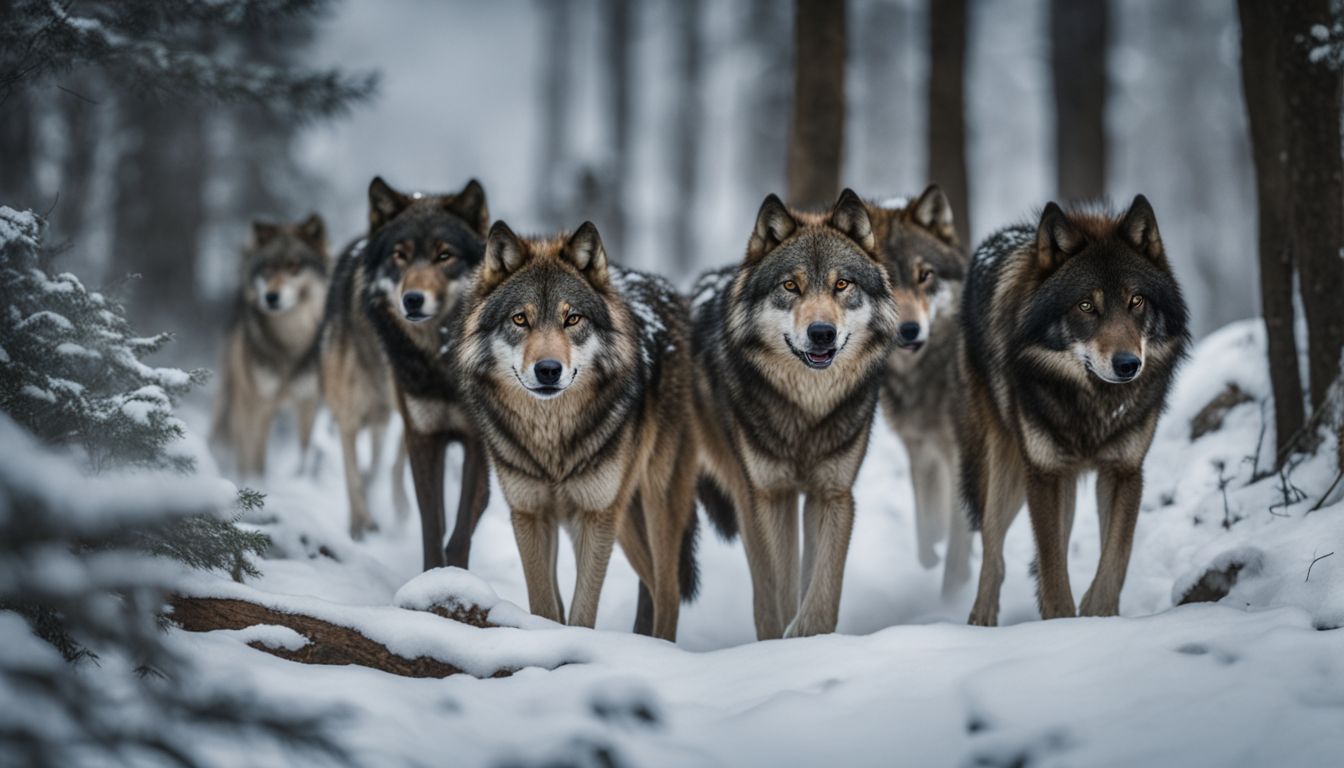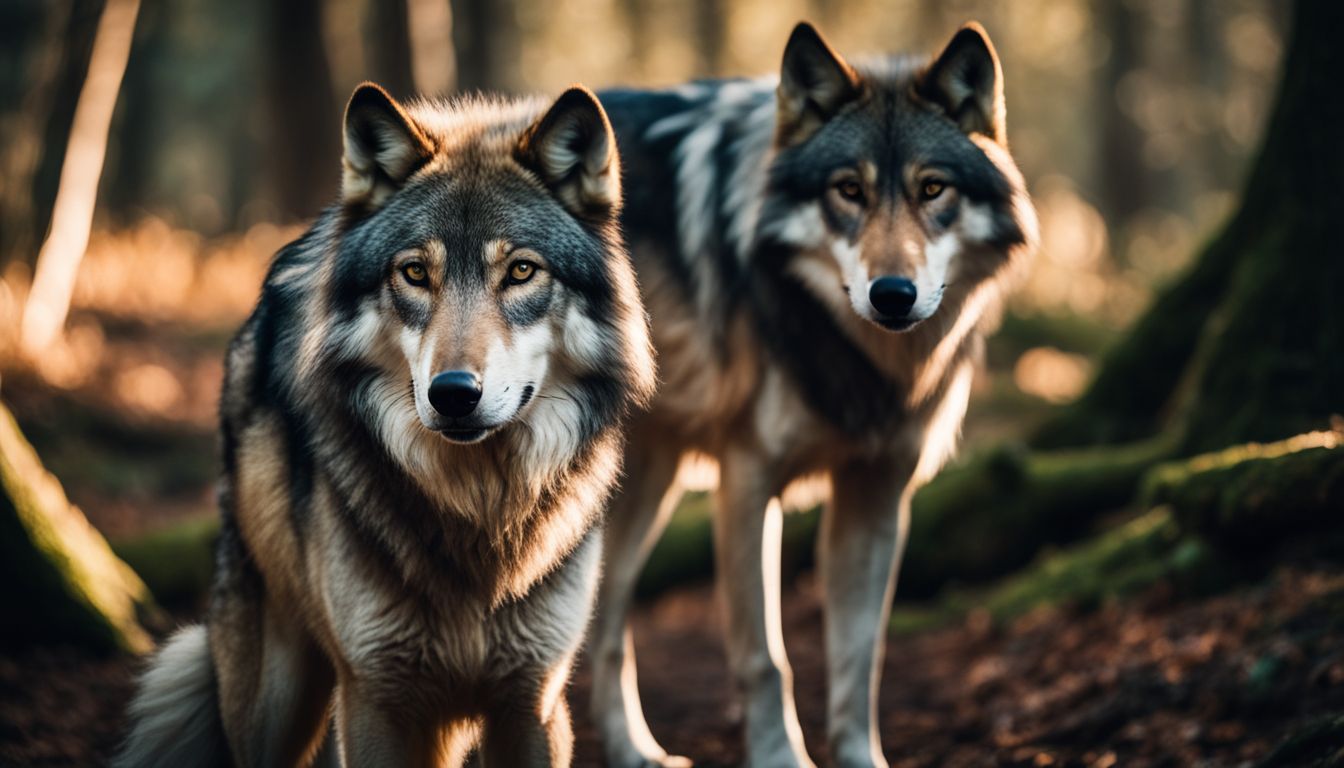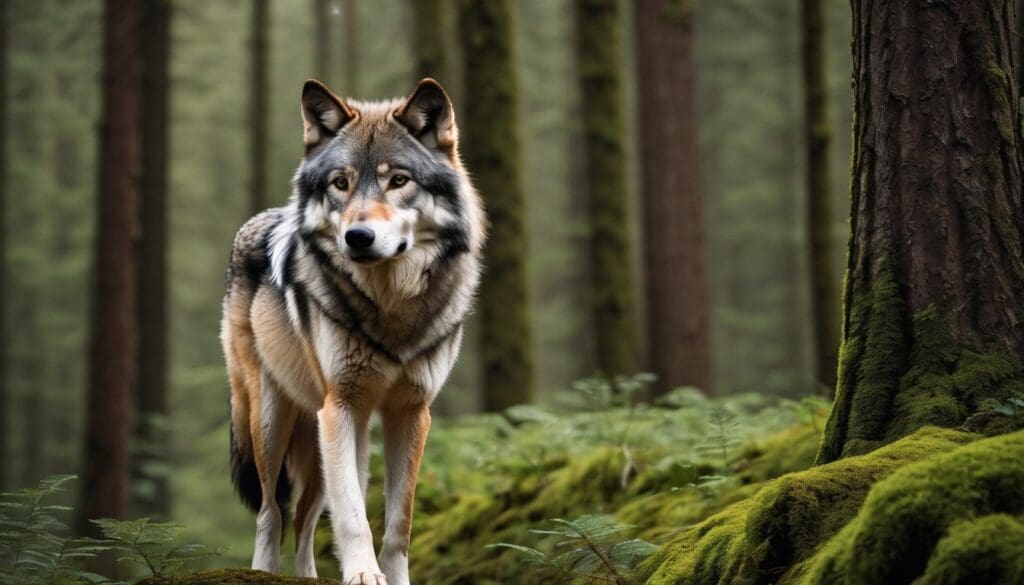Many of us carry a deep-seated concern for the well-being of our planet’s wildlife, and there’s something particularly poignant about the plight of noble species such as wolves. It’s a worry we share; like you, I’ve felt that unease and sought insight into their struggle for survival.
Grey wolves once traversed enormous expanses of North America before facing near extinction. Today, I’m keen to highlight the rewilding initiatives that are not simply reintroducing these paramount predators to their rightful homes but also mending the fabric of our ecosystems.
Join me in exploring how reviving wolf populations is proving instrumental in healing the landscapes we cherish so deeply.
Key Takeaways
- Wolves are keystone carnivores in their ecosystems, controlling populations of herbivores like deer to prevent overgrazing and promote plant growth. This helps maintain biodiversity and environmental balance.
- Since grey wolves were reintroduced into Yellowstone National Park, the resulting trophic cascade has revived vegetation such as aspen trees, reduced elk overgrazing, increased beaver populations, and improved biodiversity across the park.
- Coexistence strategies are crucial for successful wolf rewilding efforts. Initiatives include educating communities about wolves’ ecological roles, promoting non-lethal deterrents to protect livestock, and supporting species protection laws.
- Wolf reintroduction faces challenges including local opposition due to concerns about safety and livestock loss. Solutions involve community engagement, investment in protective measures for livestock, and ensuring genetic diversity of reintroduced wolf populations.
- Global rewilding initiatives have led to habitat expansion for many species including European bison and Mexican wolves. Success stories such as the rise of wolf populations in Spain demonstrate the potential for human-wildlife coexistence through conservation efforts.
The Role of Wolves in the Ecosystem

In the heart of our wild spaces, wolves play a crucial role as nature’s stewards, shaping the environment with each step they take. These majestic creatures knit together the fabric of ecosystems, influencing everything from plant growth to animal behaviour.
Keystone carnivore importance
Wolves hold a pivotal role as keystone carnivores within their habitats. Their presence can dramatically shape entire ecosystems, from the behaviour of other animals to the diversity of plants.
These apex predators keep herbivore populations like deer and elk in check, preventing overgrazing that could strip forests and fields bare.
By naturally managing these prey species, wolves promote growth and regeneration of vegetation, which then supports a myriad of other life forms. They create opportunities for other species to thrive by ensuring a balanced food web.
Keystone carnivores such as grey wolves are essential for maintaining ecological harmony in places like Yellowstone National Park and beyond. We must recognise their critical contribution to ecosystem health if we aim to preserve biodiversity for future generations.
Wolves as food distributors
We often overlook the critical role wolves play in dispersing nutrients throughout their habitats. As apex predators, they prey on a variety of animals, from elk to beavers. This hunting activity is much more than just a food source for these carnivores; it’s an essential process that influences the entire ecosystem.
After making a kill, wolves don’t consume all parts of their prey. What remains serves as an important resource for scavengers like ravens and bears. These leftovers enrich the soil with nutrients, fostering plant growth and benefiting many other species in complex food webs.
Energising the environment this way shows us how deeply interconnected life is within our wild spaces.
The Impact of Wolf Reintroduction in Yellowstone

When wolves returned to Yellowstone, it sparked a remarkable chain of ecological events that transformed the park. Their presence reshaped the landscape itself, breathing new life into an ecosystem that had been missing a key player for far too long.
Trophic cascade of ecological change
We saw an incredible transformation begin in Yellowstone with the reintroduction of grey wolves. These apex predators started a trophic cascade, a process where their hunting activities reshaped the entire ecosystem.
By preying on elk and other herbivores, wolves reduced their grazing pressure on vegetation, allowing for regrowth in areas that had been heavily browsed.
This ecological chain reaction did not stop there. With plant life bouncing back, beavers found more materials to build their dams and create habitats for other species. As ecosystem engineers themselves, beaver activity further enhanced environmental complexity and stability—resulting in richer biodiversity across the park.
Streams altered course, wetlands expanded, and bird populations flourished thanks to these changes initiated by wolf reintroduction.
Increase in beaver populations
The reintroduction of wolves to ecosystems like Yellowstone has sparked a remarkable increase in beaver populations. These industrious creatures play a crucial role in creating rich habitats for other species by building dams, which help maintain wetlands and reduce the effects of droughts.
Beavers’ activities boost biodiversity and provide essential ecosystem services that benefit both wildlife and humans.
With the return of natural predators, herbivore numbers become more balanced, giving rise to healthier vegetation along riverbanks. This growth provides beavers with the materials they need to construct their lodges and dams.
Their engineering works reshape waterways, slow down water flow, and create ponds that are vital for many aquatic organisms. As stewards of nature ourselves, we celebrate these positive changes as proof that rewilding efforts can restore ecological balance while supporting thriving wildlife communities such as those seen among beavers.
Revival of aspen and vegetation
We see a remarkable change in forests where wolves tread. Their presence reshapes the landscape, allowing aspen and other vegetation to thrive once again. Elk and deer, wary of wolf patrols, now avoid overgrazing tender shoots in certain areas.
This vigilance gives young trees a fighting chance to grow tall and strong.
Our actions set off this chain reaction of growth and life. With every sapling reaching towards the sky, we witness more birds singing amongst the leaves, more insects buzzing through the air – an entire ecosystem coming back into balance.
Let’s move on to explore how these changes ripple further across our wild spaces, rebuilding ecosystems piece by piece.
The Return of Wolves: Impact on Ecosystems
As we delve into the remarkable effects of wolf reintroduction, it’s fascinating to observe how these majestic creatures are instrumental in reshaping landscapes and revitalising ecosystems.
Our exploration uncovers both the triumphs and trials faced in re-establishing these apex predators within their historical habitats.
Rebuilding ecosystems
We’re witnessing ecosystems come to life as gray wolves tread back into their native habitats. These top predators spark a chain reaction of health throughout the environment, influencing everything from the behaviors of other species like elk and coyotes, to the regeneration of plant life.
By reintroducing these keystone species, we essentially give nature a helping hand in healing itself.
Our efforts aim to restore balance where it’s been lost. Wolves help control deer and elk populations, allowing overbrowsed vegetation to recover. This recovery leads to more stable riverbanks and better conditions for beaver dams, which create habitats for a multitude of other creatures.
Thriving ecosystems result in benefits not only for wildlife but also contribute positively towards conservation biology as a whole.
Challenges and successes
In the throes of our rewilding efforts, restoring the grey wolf to its former territories presents a slew of challenges. Local resistance, especially from ranchers worried about livestock losses, looms large over conservation initiatives.
Livestock guard dogs and improved fencing offer solutions but require considerable investment and community engagement. The balance between human activity and wolf habitats is delicate; finding common ground continues to test us.
Our perseverance has borne fruit nonetheless. Take Yellowstone’s revival as a shining example—since reintroducing wolves there, we’ve seen remarkable trophic cascades ripple through the ecosystem.
Elk populations are better managed by natural predation, allowing overgrazed vegetation to recover. This recovery supports other wildlife like beavers and grizzly bears, reinforcing the intricate web of life that defines these rich landscapes.
Each success story strengthens our resolve to continue rewilding efforts for species conservation across diverse ecosystems around the globe.
Co-existence with Wolves: The Way Forward
As we navigate the complexities of rewilding, learning to co-exist with wolves stands as a cornerstone for future conservation success. We’re investing in strategies that promote harmony between human populations and these vital predators, ensuring both can thrive within shared landscapes.
Living with wolves
Living with wolves requires understanding and respect for their role in nature. We advocate for coexistence strategies that benefit both humans and these majestic creatures, ensuring that the balance of our ecosystems is maintained.
By educating communities on non-lethal deterrence methods and the ecological importance of large carnivores like wolves, we foster a culture where fear is replaced by knowledge.
We support regulations that protect wolves under laws such as the Endangered Species Act and promote habitat conservation to secure their future. Our aim is to see landscapes where grey wolves roam freely, contributing to a healthy environment.
Engaging in rewilding projects helps us achieve this goal while we enjoy the intrinsic value of sharing our world with diverse wildlife species.
Efforts towards harmonious coexistence
We’re fostering a new era where people and wolves thrive together, respecting each other’s roles in nature. By developing non-lethal management strategies, we encourage ranchers to guard livestock without harming these pivotal predators.
Innovative tools like fladry lines – ropes with hanging flags that deter wolves – are proving effective. Similarly, range riders monitor herds on horseback, keeping the peace between cattle and canines.
Our commitment extends beyond prevention; we’re also educating communities about the grey wolf’s crucial role within ecosystems. Through workshops and outreach programs led by ecologists like Doug Smith from the Yellowstone Wolf Project, knowledge spreads about how wolves regulate prey populations and enhance biodiversity.
Our vision embraces coexistence as vital for preserving not just the wolf but entire landscapes where every species contributes to ecological equilibrium.
The Grey Wolf in Europe
6. The Grey Wolf in Europe.
We’re seeing a surge of support for the grey wolf’s comeback across European landscapes, yet it’s not without its complex tapestry of challenges that intertwine with human interests and regional biodiversity.
Support for rewilding
We see a growing wave of enthusiasm for rewilding, especially the return of wolves to their natural habitats. Across Europe, initiatives like Rewilding Europe champion the cause, breathing new life into ecosystems by reintroducing species such as the Italian wolf and iberian wolf.
By restoring these key predators, we give forests and grasslands a chance to recover from over-browsing by herbivores like deer.
Our commitment to this movement helps rebalance nature’s rhythms ecologically. In places where wolves have vanished, projects aim to bring back not just any wolf but subspecies tailored to specific regions—like Canis lupus lupus in central Europe or the Eurasian wolf further east.
Support from local communities grows stronger as they witness improvements in biodiversity firsthand. With every success story shared among us conservationists and advocates for wildlife recovery, momentum builds for future rewilding efforts across continents.
Challenges of reintroduction
Reintroducing wolves to their former habitats presents us with a complex maze of hurdles. Local communities often fear the return of a predator they haven’t seen in generations, worrying about livestock safety and wolf attacks on humans.
These fears can overshadow the ecological benefits wolves bring, making it hard for us to gain widespread support for our efforts.
We also face biological challenges – ensuring that reintroduced wolves have the genetic diversity necessary to thrive is no small task. The Mexican grey wolf, once teetering on the brink of extinction, illustrates just how delicate this balance can be.
We must work tirelessly alongside organisations like the US Fish and Wildlife Service to monitor these populations meticulously.
As we navigate these obstacles, we set our sights on harmonising human-wolf relations into a future where both can flourish—transitioning thoughts towards co-existence with wolves as the way forward.
Global Rewilding Efforts
In our pursuit to heal the planet, rewilding projects span across continents, breathing new life into diverse habitats. From majestic European bison returning to their ancient stomping grounds to Mexican wolves prowling the landscapes of New Mexico, these stories of rebirth showcase nature’s resilience and our role in nurturing it.
Expansion of wildlife habitats
We’re witnessing a remarkable transformation as wildlife habitats expand globally. By securing larger territories for animals such as the European bison and Mexican wolves, we create opportunities for these species to thrive.
It’s not just about setting aside land; it’s about connecting ecosystems to allow free movement and natural behaviours that are essential for their survival.
Expanding habitats also mean reintroducing creatures like mountain lions and beavers into regions where they’ve been absent for decades due to human encroachment. Such actions help restore the balance within different ecosystems, promoting biodiversity and healthier landscapes.
As we commit to these efforts, bear, wolverine, moose, and countless other species benefit from more space to roam, hunt, and live according to their ancient rhythms.
Success stories from around the world
In the heart of Europe, rewilding initiatives have seen a remarkable comeback for species once on the brink. The return of the majestic European wolf stands as a beacon of hope for conservationists everywhere.
Populations have blossomed in countries like Spain, where Canis lupus signatus roams once more through Iberian forests and beyond.
Our efforts extend to Italy’s sun-drenched landscapes too, witnessing the steady rise of the Apennine wolf. These triumphs pave the way for countless other restoration projects globally, igniting passion for preserving our planet’s precious biodiversity.
As we celebrate these wins, let’s turn our attention to how communities and wildlife can thrive together—a crucial step with wolves as our guide.
Conclusion
We’ve explored the critical role of wolves in maintaining ecosystem health. Their return marks a pivotal chapter for wilderness recovery. As we support these rewilding efforts, we embrace the balance that apex predators bring to our natural world.
Let’s continue championing initiatives that secure their future and ours. Together, we can witness a thriving environment where wolves roam free once more.
FAQs
1. What does rewilding mean for wolf populations?
Rewilding means bringing wolves like the Mexican gray wolves and northern Rocky Mountain wolf back to their natural habitats to restore ecosystem balance.
2. Why are wolves important in places like the Greater Yellowstone Ecosystem?
Wolves, such as those from the endangered species list including Canis lupus italicus, help maintain healthy populations of animals like bighorn sheep, wapiti, and pronghorns by controlling prey numbers.
3. Are all wolf subspecies part of rewilding efforts?
Not all subspecies are involved; however, efforts focus on those at risk, like the Mexican wolf and gray wolves in Wyoming, aiming for species recovery.
4. How do humans impact wolf reintroduction projects?
Humans can either support or hinder these projects through activities such as hunting which affects rocky mountain wolf population levels but also contribute positively by supporting policies under the Endangered Species Act.
5. Can introducing predators like cougars affect other wildlife?
Yes, alongside wolves howling again in wild areas can bring changes to animal behaviors creating a ‘landscape of fear’ that benefits creatures such as black bears and wolverines due to improved habitat conditions.
6. What challenges face Mexican gray wolves in particular during rewilding?
The biggest challenge facing Mexican gray wolves includes avoiding conflicts with human interests such as ranchers or hunters while establishing new territories within safe environments conducive for species reintroduction.





